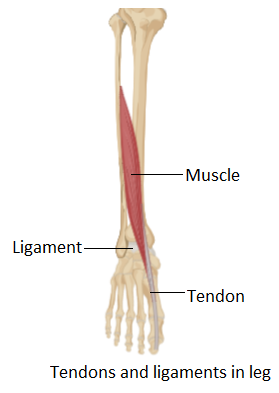
Tendons and ligaments are examples of
A. Fibrous connective tissue
B. Cartilage
C. Muscular tissue
D. Adipose tissue
Answer
552.9k+ views
Hint: Tendons and ligaments are essential components of the skeletal system as they join bones and muscles together. They are composed of parallel bundles of collagen fibers. This allows them to provide strength as well as the flexibility to the bones and muscles.
Complete answer:
Tendons and ligaments form the connecting part of the skeletal system in humans. Thus, they are connective tissues. Tendons are specialized to join a bone to a muscle and ligament is specialized to join two or more bones together. Both of them have a particular cell type called fibroblasts. The fibroblasts form the structural framework of connective tissues. Thus, tendons and ligaments are an important class of fibrous connective tissues.

Tendons are stronger and non-flexible as compared to ligaments. Ligaments, on the other hand, are more elastic and flexible. Both of them function to play a vital role in joints and bone movements. Thus, they form an integral part of locomotion in all of the higher organisms. These fibrous connective tissues have a large amount of collagen. The ligaments are further classified as articular ligaments, peritoneal ligaments and remnant ligaments. But tendons have no such classification. Ligaments are compactly packed as compared to tendons. The tendon fibres are compact and are present in a parallel bundle arrangement. Also, the fibroblasts of tendons lie in continuous rows. Whereas the fibroblasts in ligaments are in scattered form.
So, option (A) is the right answer.
Note: Tendons and ligaments lack blood vessels due to which they appear white as compared to muscles. This is also a reason for the delayed healing process of tendons and ligaments. The blood contains various specialized cells and proteins that heal injuries rapidly. But tendons and ligaments lack blood vessels due to which they take much time to recover from injuries.
Complete answer:
Tendons and ligaments form the connecting part of the skeletal system in humans. Thus, they are connective tissues. Tendons are specialized to join a bone to a muscle and ligament is specialized to join two or more bones together. Both of them have a particular cell type called fibroblasts. The fibroblasts form the structural framework of connective tissues. Thus, tendons and ligaments are an important class of fibrous connective tissues.

Tendons are stronger and non-flexible as compared to ligaments. Ligaments, on the other hand, are more elastic and flexible. Both of them function to play a vital role in joints and bone movements. Thus, they form an integral part of locomotion in all of the higher organisms. These fibrous connective tissues have a large amount of collagen. The ligaments are further classified as articular ligaments, peritoneal ligaments and remnant ligaments. But tendons have no such classification. Ligaments are compactly packed as compared to tendons. The tendon fibres are compact and are present in a parallel bundle arrangement. Also, the fibroblasts of tendons lie in continuous rows. Whereas the fibroblasts in ligaments are in scattered form.
So, option (A) is the right answer.
Note: Tendons and ligaments lack blood vessels due to which they appear white as compared to muscles. This is also a reason for the delayed healing process of tendons and ligaments. The blood contains various specialized cells and proteins that heal injuries rapidly. But tendons and ligaments lack blood vessels due to which they take much time to recover from injuries.
Recently Updated Pages
The number of solutions in x in 02pi for which sqrt class 12 maths CBSE

Write any two methods of preparation of phenol Give class 12 chemistry CBSE

Differentiate between action potential and resting class 12 biology CBSE

Two plane mirrors arranged at right angles to each class 12 physics CBSE

Which of the following molecules is are chiral A I class 12 chemistry CBSE

Name different types of neurons and give one function class 12 biology CBSE

Trending doubts
One Metric ton is equal to kg A 10000 B 1000 C 100 class 11 physics CBSE

What is 1s 2s 2p 3s 3p class 11 chemistry CBSE

Discuss the various forms of bacteria class 11 biology CBSE

State the laws of reflection of light

Explain zero factorial class 11 maths CBSE

An example of chemosynthetic bacteria is A E coli B class 11 biology CBSE




